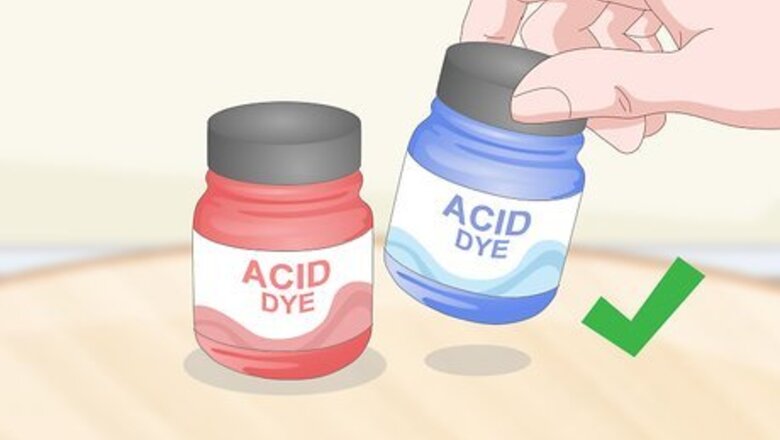
views
Choosing a Type of Dye
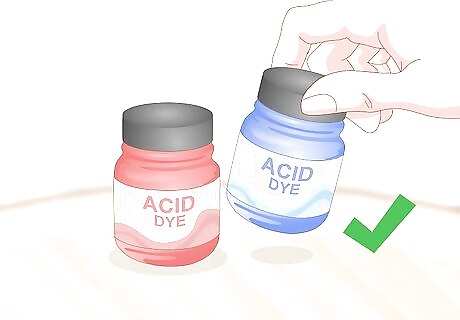
Use an acid dye to get a color that closely matches that of the packet. Because acid dyes don't have other types of dyes mixed into them (like an all-purpose dye does), the color you'll get at the end of the dyeing process will closely match the color you chose. Depending on what color of dye you want, you may need to special order it online from a dye company. The exception to the rule about color-matching is if you were to try and mix together 2 different shades of acid dyes. Each dye has multiple pigments that could mix with pigments from another dye and change the outcome of the color to be different than expected; the results might be slight but it also could be dramatic. If you want to do this, test the mixed dyes on a piece of scrap nylon first.
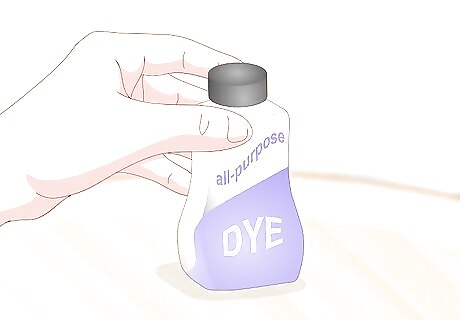
Choose an all-purpose dye for an easy-to-find dyeing option. All-purpose dyes can be found at most craft and grocery stores, making them great options for times when you don't want to wait for a special order to come in. The color of your nylon might be slightly different than what's on the box because all-purpose dyes include 2 types of dye: a direct dye for cotton and a leveling-acid dye for wool/nylon. Only the leveling-acid dye will affect your nylon. While the color won't be exact, it will still be very close to what's on the box or label. Just keep in mind that there might be a slight difference, especially if you're trying to match your nylon to the color of something else (like a pair of pantyhose with your favorite red lipstick).
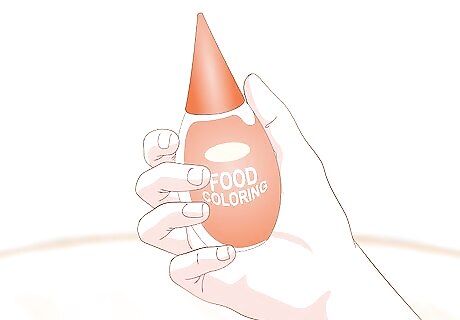
Opt for food coloring for a wide array of colors to choose from. Apart from the basic colors you might get in something like an egg-dyeing kit, there are tons of other colors available at craft stores, grocery stores, and online. You'll need about 10 drops of food coloring for each item you want to dye unless they exceed 1 pound (use fewer drops for a lighter color or more drops for a more vibrant shade). You could also use natural food extracts, like beet extract for red dye, turmeric for yellow dye, and spinach juice for green dye.
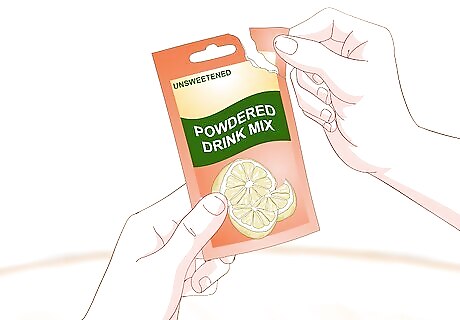
Pick an unsweetened powdered drink mix for an inexpensive option. Ideally, use a powdered drink mix that is completely free of sugar and sugar-substitutes; otherwise, the nylon will turn into a gunky mess. Plan on using 1 packet of drink mix for each item under 1 pound that you want to dye. The great thing about using a drink mix on nylon is that the color won't wash out when you clean it like it would if you used it on cotton.
Preparing the Dye Bath
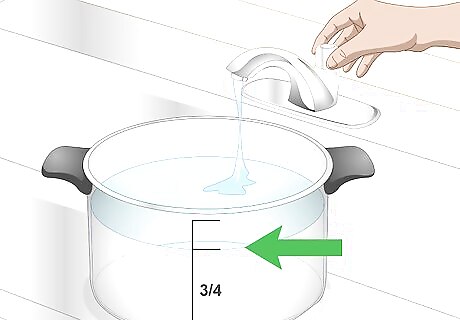
Fill a stockpot 3/4 full with water. Use a stockpot that you don't mind retiring from use with food (unless you're using food coloring or a powdered drink mix). Both acid dyes and all-purpose dyes can leave traces of chemicals even after the pot has been washed and rinsed. It doesn't matter if you use filtered water or tap water—the results will be the same either way.
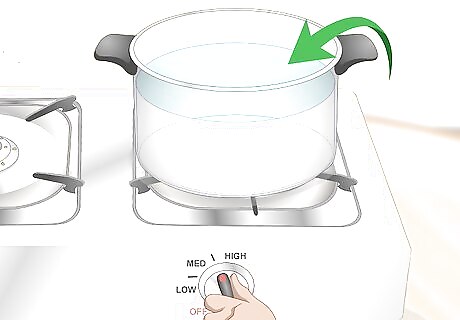
Put the pot on the stove and turn the burner on to medium-high heat. Before adding anything else to the water, start heating up the water. If you're not allowed to use the stove, make sure to ask an adult for help. Let it come to a simmer before moving on to the next step.Tip: Use a front burner rather than a back burner so that it'll be easier to stir the pot.
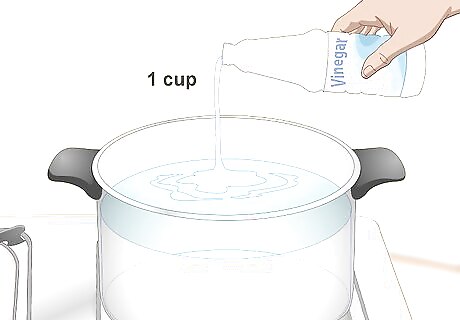
Add 1 cup (240 mL) of white vinegar to the stockpot. Nylon needs a small amount of acid in order for it to soak up the dye. Regardless of what kind of dye you use, don't forget to add the vinegar to the stockpot. If you do, your nylon won't hold the dye and it'll wash out quickly. Some brands and types of dye also call for adding a little bit of salt to the water. Check the instructions to see if this is needed. If you're using food coloring or a powdered drink mix, you don't need to add any salt.
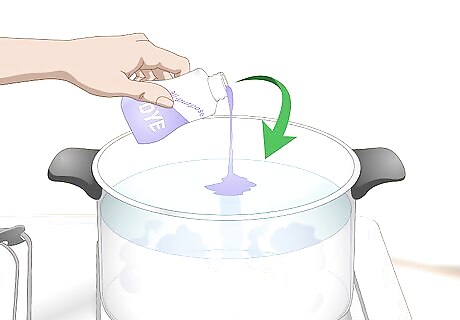
Pour the dye into the water. If you're using acid or all-purpose dye, use one packet of powder or 1 bottle of liquid dye for each pound of fabric you are dyeing. If you're using a powdered drink mix, add the entire packet of powder. For food coloring, about 10 drops should create a vibrant shade. Keep in mind that you could use more or less dye depending on how light or dark you want the color to be. Be really careful when opening packets of powdered dye. If the little granules spill, they can easily stain clothes, surfaces, and skin. Open them over the pot or over your kitchen sink. At this stage, you may want to put on a pair of rubber gloves just in case any dye gets onto your hands.
Dyeing and Rinsing the Nylon
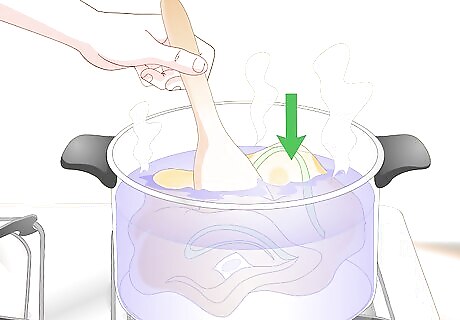
Submerge the nylon item into the stockpot. Use a wooden spoon to push it down to the bottom of the pot until the entire item is saturated. Be careful to not splash the water over the side of the stockpot. If you're dyeing small items (like pantyhose), you can dye 2 or 3 pairs at once. For larger items, try to do one at a time to make sure they're not overcrowded, which could make the color uneven. If there isn't enough room to swish the fabric around with your wooden spoon, the pot is too crowded.
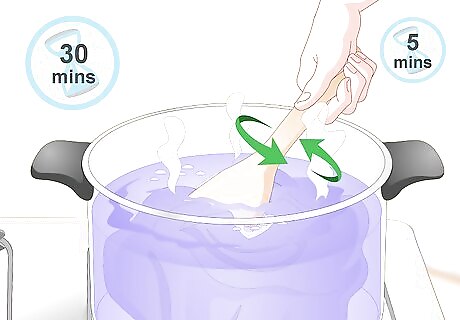
Simmer your nylon for 30 minutes, stirring it every 5 minutes. Keep an eye on the pot to make sure the water doesn't start boiling—heat is needed to help the dye set into the nylon, but extreme heat could actually damage the fabric. Plus, boiling water could get onto your stove and stain it. Remember to stir with a spoon that you don't intend to use with food again. To help remind yourself that you shouldn't use it for food, put a piece of colored tape around the handle or write on it with a permanent marker.

Use tongs to remove the nylon from the pot and transfer it to the sink. After the 30 minutes are up, turn off the burner. Put a hot pad or something similar on the counter next to the sink, and use oven mitts to carefully move the pot. Use a pair of tongs or 2 long spoons to remove the nylon from the water and put it into the sink. Make sure to clear any dishes out of the sink before you do this. To help protect your counters from potential drips, lay down an old towel on the counter first.Warning: Don't do this in the sink if it's made of enamel or porcelain as the dye will stain the sink. Instead, dump the dye down a drain in a basement or laundry room, or even outdoors. Do the rest of the work over the stockpot instead of in your sink, or use the sink in a laundry room if one is available to you.

Rinse the nylon with hot water until the water runs clear. Be careful to not burn yourself, as the nylon will still be really hot from the simmering water and it won't cool down quickly since you'll be applying more hot water. Using rubber gloves can help protect your hands from the heat while also letting you maneuver the nylon so that it all gets rinsed out. This process may take 10 to 15 minutes.

Give your nylon a final rinse in ice-cold water to set the dye. Once the water is running clear, turn the water to the cold setting and thoroughly soak the nylon. Double-check to make sure the water is still running clear. The danger of dyeing your hands should be gone by now, but still, be wary of drops of dye around the edge of your sink that you could accidentally brush up against. Use a sponge or some paper towels to continually clean up drips as they appear.
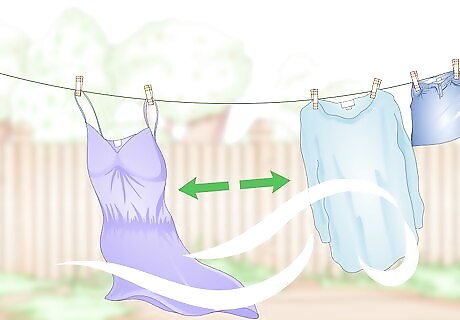
Line-dry your nylon somewhere it won't come into contact with other fabrics. If the weather is nice, hang the nylon up outdoors so it can dry in the sun. If you don't have that option, use a line indoors in a basement or laundry room. Let it dry completely before you wear or use it. Put a towel underneath the nylon to catch any potential drips. Wash recently-dyed nylons on their own or by hand for the first 2 to 3 washes so any residual dye doesn't run off and ruin other garments.
















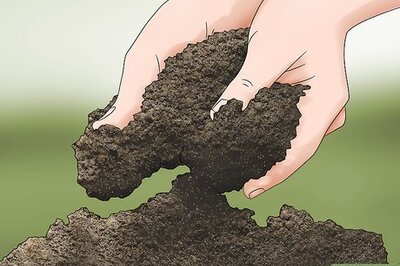

Comments
0 comment